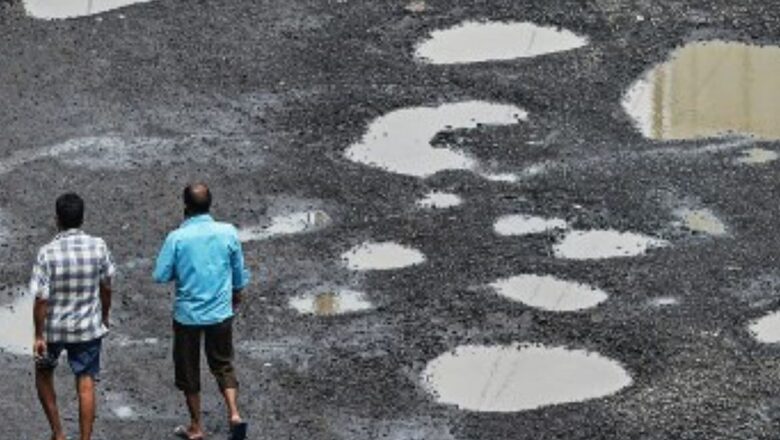
views
Bengaluru’s problem with potholes has been perennial, with civic bodies saying they would pay people who identify the pits, ministers calling them a “recurring problem” and campaigns promising “good roads and better infrastructure” in the IT city.
Earlier this month, the Bruhat Bengaluru Mahanagara Palike (BBMP) commissioner said the civic body had been conducting a survey on potholes across the city and had identified 33,000 of them and work to repair them had begun. Setting a deadline of November 19, Tushar Giri Nath said the BBMP was gearing up to declare stretches of Bengaluru “pothole-free”. The work is yet to be completed.
Despite being the home to hundreds of cutting-edge technology companies, Bengaluru is unable to adopt a successful urban management module that could help root out its death-trap roads, perennial traffic congestion, flooding issues and mismanaged garbage disposal system. Though a working model of optimal pothole management is being implemented within Bengaluru by the Electronic City Township Authority (ELCITA).
With the help of AI-based systems, ELCITA has been able to provide a working model of smart systems for the BBMP to emulate. Though engineers and civic experts warn that ELCITA’s model may prove difficult to scale up the system for a city as huge as Bengaluru with several other factors contributing to damaged roads.
ELCITA has adopted an AI-based software developed by Bengaluru’s very own RoadMetrics, a young group of entrepreneurs who created this system for specialised road management. It has helped in road maintenance and repair with the help of a simple mobile application loaded on a mobile phone and mounted on a vehicle that would survey the ELCITA-run Electronic City at regular intervals.
So, how does a pothole or damaged road is spotted and the issue resolved by ELCITA?
The camera of the mobile phone mounted on the patrolling vehicle monitors the ‘health of the roads’. If cracks are found, the software captures images of the damaged road from various angles. It also calculates the width and depth of the damage and uploads the data via an image to software driven by artificial intelligence. The location is Geo-tagged and the system then compares it with previously logged images of the road.

The AI system has an inbuilt classification to determine the extent of road damage or identify a pothole, manhole or speed break. Cracks are classified as alligator cracks, vertical cracks, raveling, surface deterioration or horizontal cracks. Once the visual image and the AI have synced in the type of damage, a physical assessment of the location is conducted by ELCITA’s team. On the completion of work, a fresh image of the rectified work is uploaded and the issue makes as resolved in their integrated management system.
“Superficial treatment of roads is a waste of money as potholes are bound to recur,” explains ELCITA Chief Executive Officer Lt. Col. Ravindra Singh to News18.
“It is very important to conduct root cause analysis especially when it comes to pothole management. We need to understand what causes the problem as potholes just don’t happen overnight. There are indications of road deterioration. The causes could be stagnation and percolation of water through the top layer to the lower layers, which may have gone bad due to various causes such as heavy vehicular movement. Not addressing the underlying problem and just superficial treatment is bound to cause the problem to recur,” said Lt Col Singh.
At ELCITA, the officials analyse whether the damages are superficial or deep. This is where the engineers need to be alert to see what is happening to the road and find a solution apt to the location. “You cannot have one solution for all locations,” Lt Col Singh further explained.
Manual inspection and maintenance based on the feedback of ground personnel or customers were time-consuming and often delayed response and action. The AI-based software helped in creating a digital map of the 800-acre IT park, and road and street asset inventory.
Speaking about their new AI-driven process, Singh added that they used to have manual inspections conducted to find the problem and repair it. Now, a system driven by AI software helps identify the problem and expedite the process with an accurate representation of the issues on the road that had been flagged. A root-cause analysis is also conducted to resolve the issue long term.
“With the software, we can classify whether a damaged has alligator cracks, vertical cracks, raveling, or the surface has deteriorated due to some seepage or due to fair wear and tear. With our constant monitoring, we can prevent potholes from getting developed. Multiple factors lead to the development of cracks and potholes. We ensure that the solution adopted enhances the roads life,” Singh said.
But can ELCITA’s model be emulated by BBMP for better management? Singh says what works for them may not optimally work for a city as big as Bengaluru. ELCITA is a privately-run township, but in Bengaluru city, the stakeholders are much larger and the issues are much more varied.
Civic evangelist V Ravichandar also agrees with Lt Col Singh that it may not be fair to compare the processes in privately-run ELCITA with the government-run BBMP.
Ravichandar says the core problem is that there is a dysfunctional system within the BBMP.
“The contracts and the tendering system are not transparent and that is the real issue when it comes to the civic body. It is not we cannot resolve the issue, but there is a rent-seeking mechanism in place, there are leakages (corruption) that happen which make it difficult to get a quality road,” he added.
He further said BBMP does not have the technology. In ELCITA, there is a professional system that works well. “They can identify the potential problem areas and address them, rather than wait for the pothole to happen and then jump around filling it as we see in Bengaluru. The real issue here is that the government does not have the will to address the issue,” he said.
Forget about artificial intelligence, even if there is a system where the citizen can geo-tag an area that has a pothole, the BBMP will have a large amount of real-time data that they could use. This transparent process could yield results but being opaque is in government’s DNA, Ravichandar further explains.
He also adds that the technology will be of no use as the model of contracting, road laying and pothole fixing in the BBMP is not transparent. “A good road network is not a rocket system but getting there will need political will and administrative competence,” said Ravichandar.
Read all the Latest India News here
















Comments
0 comment